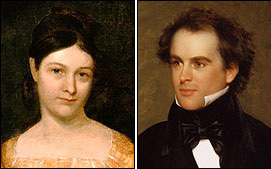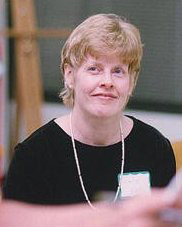Professor Studies Woman Behind The Man
 |
| Sophia Hawthorne, wife of American author
Nathaniel (right), was not only a prolific writer but
a trusted editor for her husband's works. |
Sophia Peabody Hawthorne was more than just the wife of the
great American novelist Nathaniel Hawthorne.
She was a great writer, editor and a published author, as
well as someone from whom Nathaniel drew much influence, according
to SHSU associate professor of English Julie Hall.
“We can say she was almost a literary professional in
that time period,” Hall said.
On Monday afternoon, Sophia and Nathaniel were reunited for
the first time in almost 150 years, when her remains and those
of their daughter Una were moved from a London cemetery to
the Hawthorne family plot in Concord’s Sleepy Hollow
Cemetery, in New England.
The decision to re-inter the remains was made by both Hawthorne
descendants and nuns from the Dominican Sisters of Hawthorne
after a tree fell over and damaged the graves.
“It (Nathaniel and Sophia’s story) is supposed
to have been one of the great love stories in American literature;
that’s what people often say of it,” Hall said.
“We do have, preserved, all the love letters that Nathaniel
wrote to her, and indeed they do testify to a wonderful love.
“Most people are very, very happy that she is being
brought back, because we want to see them together in death
as in life,” she said.
Not only was it a momentous opportunity to reconnect the two
lovers, but Hall said she is happy for the opportunity to
bring attention to Sophia as more than just “the other
side” of Nathaniel.
 |
Julie Hall |
Hall, who has studied the Hawthornes for over 15 years and
wrote her dissertation over Sophia, was just recently interviewed
in a story about the lesser-known Hawthorne for the Boston
Globe.
“I think she has been underappreciated, but she’s
been gaining increasing attention in the past 10 or 20 years,”
she said. “As we saw with this article, it just sort
of brings her back into the public mind. It makes people question
who this woman was and what she did.”
And just what did she do?
“She wrote all of her life in forms that were more accepted
for women in the 19th century,” Hall said. “There
was resistance to women authors, women who published, but
it was OK if they wrote privately, such as letters and journals.
“What we have of hers are her journals and letters and
one book that was published after Hawthorne died,” she
said. “It was a travel book, and those were very, very
popular in the 19th century. It was based upon the Hawthornes’
life abroad, from 1853-1860.”
The book, “Notes in England and Italy,” was published
five years after Nathaniel’s death, in 1869.
Hall said she believes the reasons Sophia, which she pronounces
as Soph-eye-a, waited until after her husband’s death
to publish any of her works were multifaceted, including the
non-acceptance of women writers and the desire not to overshadow
Nathaniel while he was alive.
“One factor in her publication was that she needed the
money for herself and her three children, so she turned to
her writing as a way to make money,” she said, adding
that it’s all just speculation without speaking to Sophia
herself. “Also, during that time after his death, she
edited Hawthorne’s private notebooks and journals. That
was a huge enterprise that was at least four different volumes
of notebooks and journals, and it took her about six years
to do that.”
Called “perhaps the first American Transcendentalist
nature writer” by another scholar interviewed for the
Boston Globe story, Sophia’s contributions to literature
are “of a lot of value,” Hall said.
“In the book that I co-edited, my essay is on the letters
that she wrote,” she said. “These would have been
private letters, some of them to Nathaniel, during the Civil
War, so they have great historical value in and of themselves.”
Her place in American literature is also found in her contributions
to her husband’s work, serving as a model for some of
Nathaniel’s fictional women.
“Another more direct means of influence was the fact
that he actually used one of her journals, and he ‘lifted’
passages from her journal and used them in two of his short
stories,” Hall said. “She was OK with the shared
glory for most of her life, but at the same time, she was
a very accomplished woman, and that’s what I think we
need to take note of.”
So revered was she and her gifts, both writing and editorial,
by her husband that she and Nathaniel collaborated on several
works, including a honeymoon journal, in which the two responded
to each others’ entries, that was fully published in
2006. Before 2006, only Nathaniel’s parts had been printed.
“After he composed his fiction, his short stories and
his novels, he read every single one of them to her, or she
read them in manuscript before he sent them to his publisher,”
Hall said “So that tells us something of her importance
to him.”
The whole notion of the “woman behind the man”
was quite common during that time, Hall said, listing Mark
Twain and his wife as both another example and a couple to
whom the Hawthornes have been compared.
“I think this woman behind the man deal with women and
men writers is probably much more common in the 20th century
because there were so many more obstacles to women becoming
published authors, so they often sort of satisfied their desires
through their mates,” she said.
The book Hall is co-editing on Sophia, “Reinventing
the Peabody Sisters,” is due out in November but is
already available on www.amazon.com.
—END—
SHSU Media Contact: Jennifer
Gauntt
June 26, 2006
Please send comments, corrections, news tips to Today@Sam.edu.
|


